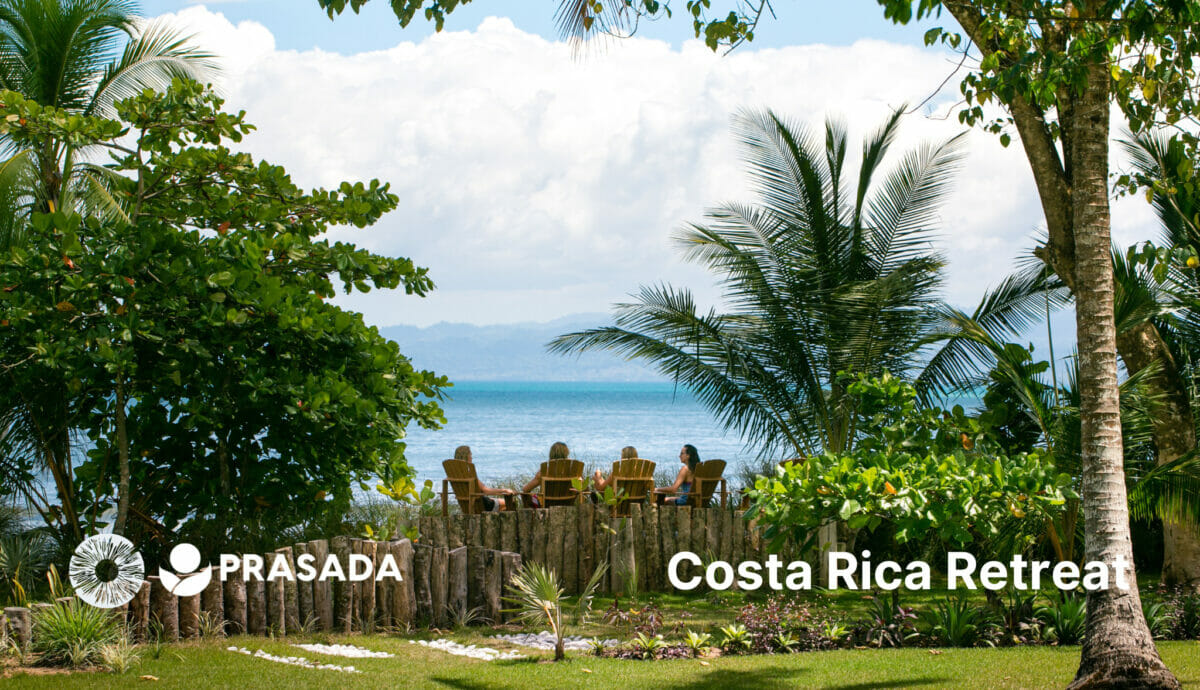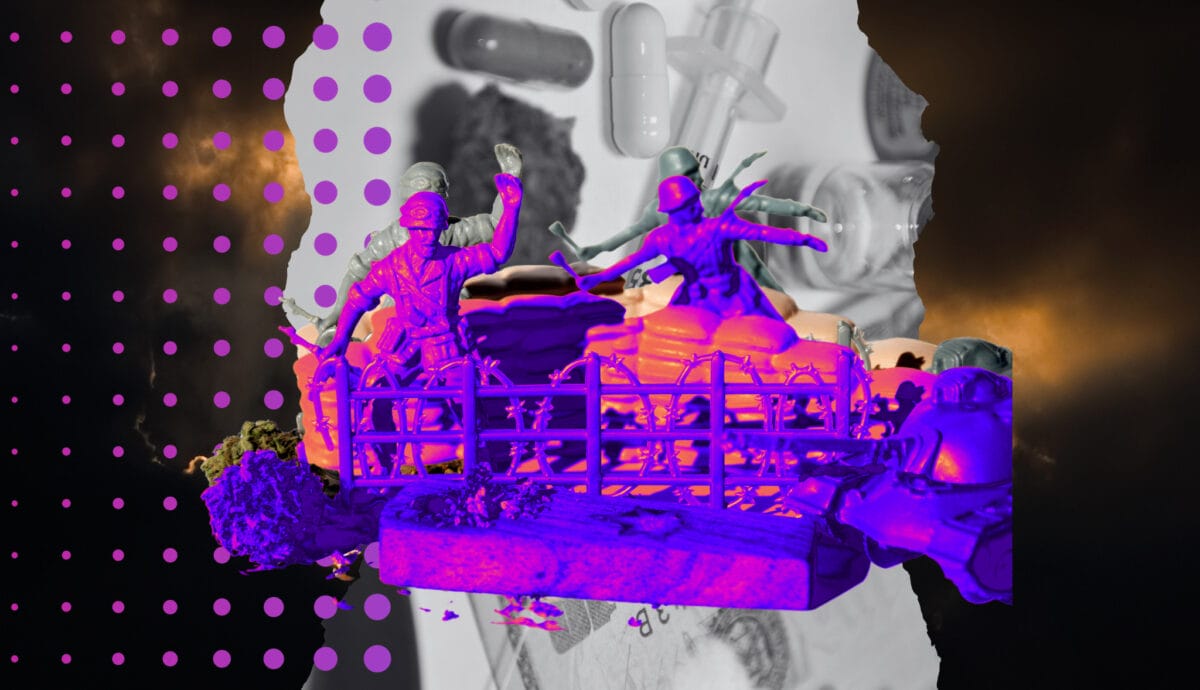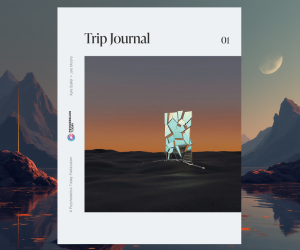Amidst the fervent cries of psychedelic-centric victory heard around Colorado since the passing of the Natural Medicine Health Act (NMHA), it is important to remember those less publicized, less well-funded, and less white, human beings who continue to suffer and die from various manifestations of the War on Drugs – the same political ill that prevented access to “natural medicines” in the first place.
A malignant disease afflicting the collective body of culture, the War on Drugs is among the most horrific, anti-human disasters in the history of American policy. Lack of access to psychedelics is one symptom of this disease, but there are many others; including the opioid overdose epidemic, mass incarceration, the creation of Mexico’s narco-state, the militarization of police, the erosion of personal rights, and continued institutionalized racism. Like a very expensive band-aid triumphantly placed on the skinned knee cap of a dying person by self-congratulatory doctors, the NMHA does absolutely nothing to alleviate these most malignant symptoms of the disease that is the War on Drugs. In this way, the NMHA and other psychedelic-centric drug policies paradoxically represent the continuation of oppression more than its end.
Passed on November 8th, 2022 by Colorado voters through a ballot initiative, the NMHA brought immediate statewide decriminalization and pending legalization of certain “natural medicines” including psilocybin, DMT, mescaline, and iboga. Those unfamiliar with the details of the NMHA can read about them extensively here. As far as psychedelic policy goes, the NMHA is a reasonably cutting-edge development, merging both legalization and decriminalization models. But there is no such thing as a “psychedelic policy,” only drug policy.
Dr. Carl Hart, Columbia University’s Department of Psychology Chair, defines the problem succinctly as “psychedelic exceptionalism,” “the perspective that psychedelics are somehow better and more useful than other classes of drugs like opioids or stimulants.” This rampant false belief that psychedelics can be meaningfully separated from the larger drug policy conversation enables the generally privileged and up-power “psychedelic community” to ignore prohibition itself as the core societal disease while profiting from the treatment of a single symptom. Rather ironic, really.
Gazing through the glamor and capitalist speculation currently surrounding the psychedelic phenomenon reveals a more essential truth: Psychedelics are morally-neutral substances just like any other. Our inability to see this is our responsibility, but, in part, not our fault. America has a long-standing tradition of simplistic moralistic judgments around substances which began with the Women’s Christian Temperance Movement in the 1800s and continued through programs like D.A.R.E. Our cultural soil is deeply seeded with the idea of “good drugs” used by “good people” and “bad drugs” used by “bad people.”
After decades of wrestling with this tired old narrative, we’re finally managing to change it, but only along those same dualistic lines of thinking. By highlighting the positive effects of psychedelics, we have begun to politically pry some useful substances from the realm of “bad” drugs. The DEA is now considering releasing MDMA from its unscientific schedule I clutches while states legalize and decriminalize some psychedelics. This is the entire basis of the psychedelic renaissance. What has unfortunately not been considered is the problem with assigning a moralistic value to substances in the first place. In a compensatory over-swing of the flawed rhetorical pendulum, “psychedelic people” and their “medicines” are now coming to be seen as “good.” Such thinking leads predictably to unjust policy outcomes. This is, after all, the same fallacious logic that sparked the War on Drugs in the first place.

The categorical separation of “good” drugs and “bad” drugs is synonymous with the assignment of human beings into those same categories. The prevalence of this bias in the psychedelic space, implicit or explicit, betrays a deep lack of contextual awareness leading to oppressive behavior, which is contrary to the kind of societal-level healing that the movement claims to represent. Despite the political utility of rhetorically distancing psychedelics from other substances, our “natural medicines” are still ultimately “drugs” that must be considered within the larger context of American drug policy.
The Cultural Context of Psychedelics: A Brief Reminder of The War on Drugs
To triage the symptoms of prohibition, addressing each by their lethality, reveals a clear picture of the injustice inherent in a myopic focus on psychedelic-centric policy change. While it’s true that lack of access to psychedelics is preventing untold numbers of people from receiving helpful treatments for things like anxiety, depression, PTSD, addiction, etc., these kinds of maladies are collectively overshadowed by more immediately fatal symptoms of prohibition.
Itemizing the harms of the War on Drugs is something akin to sorting through the rubble of a war-torn metropolis while bombs are still falling – an extensively horrific task far exceeding the scope of this article. Two vignettes that partially describe the scope of destruction can be found in the interwoven phenomena of the opioid epidemic and mass incarceration; two direct symptoms of the War on Drugs.
The number of people who died from opioid overdose in 2022 was the equivalent of a 9/11 attack every 2 weeks, and rising in 2023. After September 11th, 2001, the U.S. reacted swiftly to pass a series of sweeping legislation, initiate new programs, and even go to war in Iraq and Afghanistan. Opioids clearly kill many times more people than terrorism ever has, but no such action is being taken. We won’t even mention the fact that opium production in Afghanistan was higher under U.S. control. The solutions to the opioid problem can be clearly found in harm reduction-based policies such as those implemented in Canada and Portugal. These policies stand on much firmer empirical ground than those arguments that drove our country to war in the Middle East, so where is the commiserate response?

The Centers for Disease Control and Prevention calls the recent spike in overdose deaths the “third wave.” It kicked off in 2013, is around nine times larger than any other overdose “wave” in history, and is primarily due to synthetic opioids like “illicitly manufactured fentanyl” and carfentanil. Fentanyl has long been found as an adulterant in compounds sold as heroin, but in recent years, it’s also been found in things that are not opioids like MDMA and cocaine. Fentanyl’s prevalence as an adulterant is directly tied to the underground market that was created by the War on Drugs.
Throughout alcohol prohibition in the 1920s, simple logistical realities incentivized clandestine distillers to manufacture the strongest possible concentrate of their drug, and moonshine was born. It was both easier to conceal and more profitable per gallon than beer or lesser-proof spirits. Fentanyl is the same story. One pound of Fentanyl is as potent as nearly 50 pounds of heroin, and one pound of carfentanil is as potent as 100 pounds of heroin. Which is more likely to be smuggled across a border? The manufacture and indiscriminate distribution of the most lethal substances is not stopped by the War on Drugs, it is directly caused by it.
An article published in the Journal of Law, Medicine, & Ethics titled “We Can’t Go Cold Turkey: Why Suppressing Drug Markets Endangers Society” names U.S. drug policy itself as a “key accelerant that transformed this wave of addiction into an inferno of death, disease, and personal destruction.” It’s well known that a policy approach centering harm reduction and public health over criminal punishment greatly reduces overdose deaths. Yet, we continue to quietly tolerate more than a hundred thousand American deaths each recent year.
Overdose is only one of many dark manifestations of prohibition untouched by psychedelic-centric policies. The United States, the “land of the free,” only has 4% of the world’s overall population, yet holds 20% of the prison population. Of those people in U.S. prisons, 45% are there for nonviolent drug offenses. This means that nearly 10% of human beings in prison on planet Earth are imprisoned in the United States as non-violent victims of the War on Drugs.
The outcome of American drug policy is so horrifically maligned with the logical goals of such policies (public health & safety) that one can’t help but question the intentions of policymakers. Far from the realm of fringe conspiracy, we have seen institutional harm inflicted intentionally on substance users in the past. In the 1920s, the U.S. Government intentionally poisoned alcohol heading for the underground market, resulting in the death of at least 10,000 people. This action was justified using logic that claimed people who use drugs are bad, morally reprehensible humans – that same tired old trick of moral conflation. If the goal of the War on Drugs was to reduce drug use and create a safer society, then it has failed horribly. If the goal is to punish “bad” drug users in some of the most severe ways imaginable, then the War on Drugs has been a resounding success.
Through the lens of trauma-informed care, which invites us to see substance use as a result of trauma, the situation becomes downright sinister. A common American story might be told as such: A traumatized person turns to substances as a momentarily helpful coping mechanism. (Those with 4 or more Adverse Childhood Experiences are 1,350% more likely to abuse opiates than the general population). As a direct result of prohibition itself, the substances they find on the street are concentrated to the highest potency imaginable. There are few, if any, harm reduction or effective mental health services available. Instead, a militarized police force backed by an 80-billion-dollar prison industry is actively seeking to put this person in a cage – that is if they don’t overdose first. It is into this maelstrom that policies like the NMHA interject: “Legalize psychedelics!”
Why Only “Natural Medicines”?
A report from the Colorado Department of Public Safety on substance use trends does not even mention psilocybin or other psychedelics as relevant factors in state public health. The report does, however, describe an increase in fentanyl-related incidents including lethal overdose, explaining that 275,569 doses of fentanyl were seized in 2021. According to the Denver Open Data Crime Catalog, only 14 people were arrested for psychedelics in 2021, and 24 people in 2020. For opioid arrests in those same years, the numbers were much higher: 236 and 348 people respectively. The numbers were even higher for the worst outcomes, with an average of about 1,000 people dying every year in Colorado from an opioid overdose. In this way, psychedelics are not an immediately pressing issue from a law enforcement or public health perspective. So why do they continue to be the sole focus of organized and well-funded political efforts such as that which birthed the NMHA? Why has this particular symptom of prohibition received so much attention, funding, and policy action?

Interest Convergence: Suddenly The Privileged Care About Drug Policy
It’s an unfortunate truth that our beloved Renaissance and all of the psychedelic research and policy are predominantly reflective of white interests. One historian asserts that “psychedelic culture [is] dominated by privileged white men.” Indeed, a recent U.S.-based survey of over 41,000 people found that more than half of the white respondents had used psilocybin or LSD, “whereas less than one-quarter of Black [people] reported lifetime psilocybin use.” A relevant meta-analysis examining 18 studies on psychedelic-assisted therapy that occurred between 1993 and 2013 revealed that “82.3% of the participants were non-Hispanic white.” Psychedelic exceptionalism appears to have firm roots in institutional racism and white privilege.
“Under the theory of interest convergence, there will be no racial progress unless the interests of the marginalized align with the interests of those in power,” said the dean of equity and inclusivity at the University of Pittsburgh School of Law, Tomar Pierson-Brown. Drug use itself is nearly universal, and a full half of the people in the United States 12 years and older have used illegal drugs at least once, but there have always been substantial practical disparities in the way our culture takes and politically relates to substances based on arbitrary categorization.
Despite the fact that white people use drugs at higher rates, Black people are nearly three times as likely to be arrested for them; and people of color now make up more than 66% of the U.S. prison population while representing only 37% of the general population. Overdose rates also display increasing disparity across racial and economic lines. Between 2019 and 2020, overdose death rates throughout the U.S. rose 44% for Black people, 39% for American Indian/Alaska natives, and only 20% for white people. Counties with greater economic inequality saw Black people die from overdose twice as often compared to counties with more equal economic distribution.
As if by design, historically oppressed groups suffer and die from the War on Drugs at higher rates than white people. Though the recent intensification of overdose deaths allows a more clear view, we have seen these same kinds of disparities for decades with little attention given. Besides MAPS, which is perhaps the first pharmaceutical company in history to explicitly oppose the War on Drugs, there have been few for-profit organizations working to fight prohibition in any way. Now we see psychedelic ticker stocks, psychedelic venture capitalists, and psychedelic certificate programs all vehemently fronting the narrative of “healing” while functionally ignoring the collective disease that is the War on Drugs.
It seems institutional racism, the at-scale death of opioid users, and mass incarceration were not enough to attract the attention of the wealthy and powerful to drug policy. Only the promise of greater wealth has been sufficient to finally stir society’s biggest players into support of limited reform. Suddenly, every venture capitalist is a psychedelic advocate, but where are the drug policy advocates? After all, the only true difference between the heroin dealer and the “psychedelic entrepreneur” is that one is on a side of the culturally created narrative which happens to be favored at this particular moment in history. Tomar Pierson-Brown puts it succinctly in saying: “It’s not irony, it’s interest convergence.”

Healing Without Harming: Anti-Oppressive Psychedelic Advocacy
Psychedelic modalities are without-argument desperately needed as accessible tools for front-line mental health professionals, but policy efforts focused on them exclusively are oppressive. Ibram Kendi, author of How to be an Antiracist, explains that “there is no such thing as not racist, there are either anti-racists or racists.” In this same way, drug policy is either anti-oppressive or oppressive. There is no in-between. Without applying this attitude, policy and organizational efforts within the psychedelic space are destined to become embodied examples of oppression.
Anti-oppressive approaches “minimize the effects of structural inequalities, social hierarchies, and power differentials.” As we have seen, psychedelic-centric policies like Colorado’s NMHA actually accentuate the power of the dominant groups and do absolutely nothing for the people suffering most from the War on Drugs. Drug policies like the NMHA neglect the most destructive aspects of the War on Drugs in favor of the more profitable, ‘sexy,’ and privilege-aligned substances (like psychedelics). These kinds of policies pander to the dominant culture while ignoring the core problem.
Fervent psychedelic purists (I know because I used to be one) will argue that making psychedelic healing widely available would lead to the amelioration of addiction. While this is true to a degree, it would not happen fast enough to meaningfully stem the tide of overdose deaths and is a backward way to approach the problem; like using nicotine patches to treat lung cancer.
Anti-oppressive psychedelic advocacy must necessarily include and prioritize an end to the War on Drugs as a whole, not just psychedelic legalization or decriminalization. The systemic situation that prevents access to psychedelics is the same that has created the overdose epidemic, mass incarceration, and a slew of other hugely destructive phenomena. It’s the War on Drugs and the disease of prohibition. As beneficiaries of recent drug policy changes, psychedelic institutions of all kinds have a clear responsibility to advocate for an end to the War on Drugs writ large. To ask “How can I make a psychedelic dollar?” without simultaneously asking “What can I do to help end the War on Drugs?” is unjust and tone-deaf. Only by directly addressing the core disease itself, and not just a single symptom, can we begin to truly heal as a culture.



